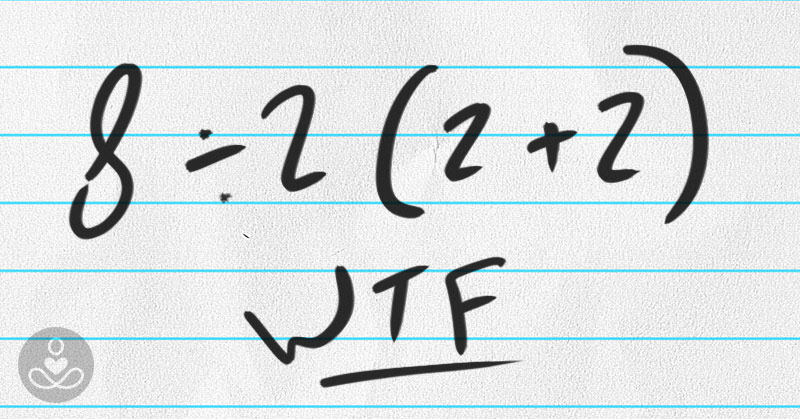The Viral Math Problem That Has People Up In Arms : The Hearty Soul

The internet is up in arms over an unexpected feud: a seemingly simple math equation.
We’ve seen these types of internet feuds before, think “the dress” debate in February 2015. People argued whether the lace was blue and black or white and gold. The original dress was later confirmed to be blue and black, but the phenomenon revealed the differences in color perception and the scientific community even used it as a subject for research. [1]
A more recent debate was the auditory illusion of “Yanny or Laurel,” which spread across the internet in May 2018. The auditory clip was barely a second long but gathered over 500,000 people on a Twitter poll, where 53% heard a male voice saying “Laurel,” and 47% heard “Yanny.” This happened because of the mix sound frequencies in the recording. Those who focused on the higher frequencies or who listened to it in faster track heard Yanny. The opposite was true for Laurel. The original recording was made by a student playing the word “Laurel.” [2]
While those were both pretty extreme viral sensations, there are always other lesser-known online feuds. This one isn’t a visual or auditory trick, but rather a seemingly simple math equation. What’s going on here?
The Viral Math Problem
Before reading on, take a look at the equation yourself. What do you think the answer is?
8÷2 (2+2) =?
Most people got the answer of either one or 16, which is strange because math is supposed to be objective. Unlike the dress or “Yanny vs Laurel” where people can agree to disagree, math is math. It isn’t a matter of opinion.
Fights broke out on Twitter over this answer with people attempting to ‘school’ others ‘who clearly don’t know what they’re talking about.’
After a long-winded argument, the experts stepped in to stop the cyber-gunfire. Turns out, the answer may depend on where the person studied math.
The PEMDAS method calls for the order of operations as follows: Parentheses, Exponents, Multiplication, Division, Addition, Subtraction, normally from left to right.
“According to order of operations, you solve whatever is in the parentheses first. That gives you 4. Then, in PEMDAS, multiplication and division take equal precedence, so you’d do the first that occurs from left to right. So you’d do 8 divided by 2 first, which is 4. Thus, it’s 16 according to classic order of operations,” said Mike Breen, the public awareness officer for the American Mathematical Society.
“According to strict order of operations, you’d get 16, but I wouldn’t hit someone on the wrist with a ruler if they said 1.” [3]
There’s another order of operations called the BODMAS method: Brackets, Orders, Division, Multiplication, Addition, Subtraction. The people who had learned this rule got the answer 1.
So Who’s Wrong?
Well, no one, except the writer of the equation.
“The way it’s written, it’s ambiguous,” said Breen. “In math, a lot of times there are ambiguities. Mathematicians try to make rules as precise as possible.”
With both answers being right, the fault lies with the creator. The equation was written with an incorrect notation specifically to spark outrage and a battle of “who’s smarter.”
Rhett Allain, Ph.D., Associate Professor of Physics at Southeastern Louisiana University, gave his take on how it worked.
“This is the math version of, ‘What color is this dress? Blue and black or gold and white?’” he said. “My answer is that you do parentheses first, so that becomes: 8/2*4. Next, you go from left to right. 8/2 is 4, so it is 4*4. Now you get 16.
“Of course, this isn’t math. This is convention. We have conventions on how to write these things just like we have conventions on how to spell stuff. But still, there are different conventions. Some people spell it as ‘gray’ and others as ‘grey.’ We still understand what’s going on.
“For me, I would write this more explicitly so that there is no confusion. Like this: 8/(2*(2+2)), if that’s what you are trying to do. That way no one will get it wrong.” [4]
The Effects of Viral Debates
The dress, “Yanny and Laurel,” and the math problem do more than spark feuds on the internet. They teach us something startling.
See, these fights will continue as long as humans exist, because each person views the world differently. Everyone knows this, but it’s still a hard fact to swallow. Reality is built on what a person views and experiences, but these things vary for every individual. This is a scary concept and slaps a person in the face when others insist on seeing the dress’s colors differently, or hearing Yanny instead of Laurel, or solving the math problem ‘wrong.’ In a small way, it threatens an individual’s reality.
When we have an idea, we close our minds to anything that contradicts that belief. This is called confirmation bias. It may be why the two sides of the online debates form such strong teams filled with people backing each other up.No one has all the facts. There are always people, stories, and worlds happening that we may never know about. Listening to others with an open mind exposes us to things we never knew we never knew. Maybe the dress is white and gold. Maybe the recording is saying Yanny. Maybe the answer is 16. These viral debates can become learning experiences, instead of squabbles we get tired of hearing about. [5]
Sources
- Karen Weintrub. Blue or White Dress? Why We See Colours Differently. https://www.nationalgeographic.com.au/science/blue-or-white-dress-why-we-see-colours-differently.aspx May 16, 2018
- Chloe Watson. Laurel or Yanny explained: why do some people hear a different word? https://www.theguardian.com/technology/2018/may/16/yanny-or-laurel-sound-illusion-sets-off-ear-splitting-arguments May 17, 2018
- Matt McNulty. Viral Math Problem Divides the Internet: Can You Solve It the Right Way? https://people.com/human-interest/viral-math-equation-causes-debate/ Aug 2, 2019
- Andrew Daniels. This Simple Math Problem Drove Our Entire Staff Insane. Can You Solve It? https://www.menshealth.com/trending-news/a28579695/viral-math-problem-2019-solved/ Aug 1, 2019
- Karyn Hall. Ph.D. A Few of the Many Ways We Distort Reality https://www.psychologytoday.com/intl/blog/pieces-mind/201208/few-the-many-ways-we-distort-reality Aug 30, 2012





